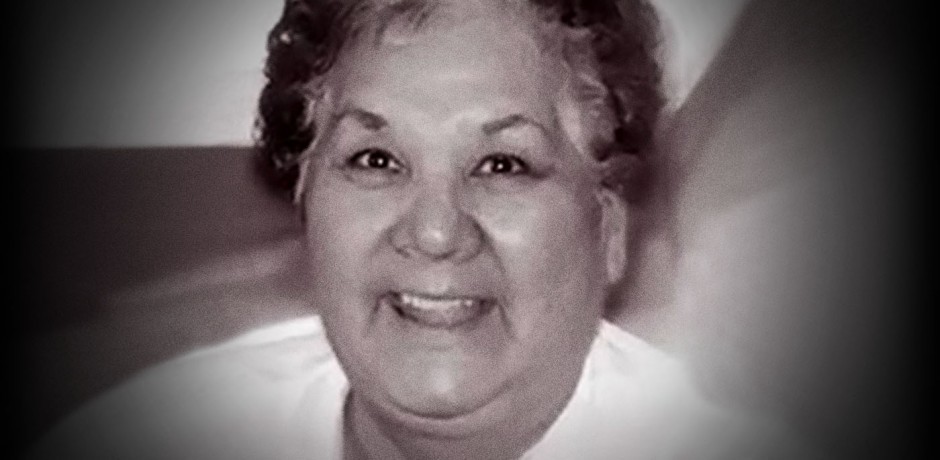Content warning: police violence, anti-Indigenous slurs
On the night of October 5, 2001, Gladys Tolley was struck and killed by a Sûreté du Québec cruiser near Maniwaki, Quebec. Part of Bridget Tolley, her daughter, also died when she heard the news. Bridget went looking for answers about what happened, but only found more questions to ask. A year later, she discovered that the police had terminated the investigation into her mother’s death without informing her. She took arranging a second investigation into her own hands. Those hands balled into fists that knocked on the doors of cagey police. Those hands clutched telephones as she spoke to politicians and grasped signs bearing Gladys’ face as she spoke at vigils. The fingers of those hands also massaged her temples as she slumped over her table and wondered how much longer it would take before a second investigation was ordered.
It’s been fifteen years so far.
Part One: Sugar Mountain
Gladys Tolley was born in 1940 in Maniwaki, Quebec, a town an hour and a half drive north of Ottawa. She grew up on the nearby Kitigan Zibi Anishinabeg reserve, though attended school in Maniwaki until she dropped out to support five younger siblings. Nothing came easy on the reserve. “Everybody’s just trying to live day by day,” Bridget explained. Gladys and her mother, Agnes Cayer, worked as chambermaids in a hotel. Some might have resented having to drop out of school, but “that was one of her things that she really liked to do, clean the rooms at the hotel,” Bridget recalled.
She liked the forests of Kitigan Zibi even more. There she watched animals, hunted, and fished. The spaces between her toes filled with hot sand as she walked down the shore of Cayer’s Lake, named after Agnes, then waded past rocks slimy with algae before she dived into the water. Gladys’ grandchildren and great-grandchildren still swim there today.
Gladys grew into a woman who radiated gentle happiness. Smiling, Bridget said, “everyone gets mad now and then, but she didn’t have a cross bone in her body […] She was a really, really happy, soft-spoken woman.” In the photo of Gladys that Bridget shows at rallies, Gladys beams with high eyebrows and a smile that bunches the cheeks beside her large, round nose. In a photo of a 1996 family reunion, Gladys sits with a laidback grin, her arm around her mother’s shoulders.
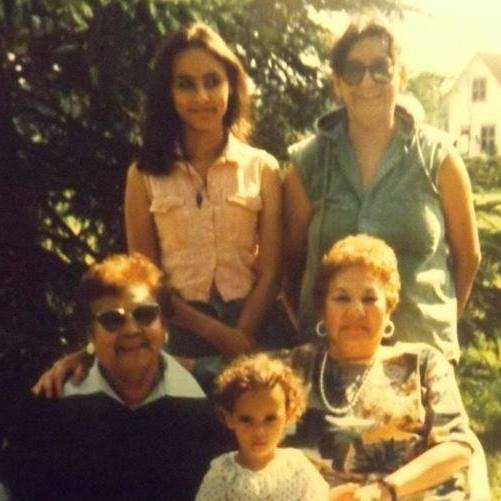
Gladys married John Tolley and gave birth to Bridget and her siblings. She took her children on rides through the forests of Kitigan Zibi.
Then she couldn’t.
When John and Gladys divorced, John wouldn’t let Gladys visit the children. “We didn’t really get to grow up with her, but she was always there. She would come and visit us every chance she got, even if it was for five minutes when my dad wasn’t there,” Bridget laughed. “So those were really good memories of her.”
But not all of Bridget’s memories are good. When she was eleven, John Tolley “shot himself in the heart, and he died instantly too.” The children then lived with their grandmother, assisted by social workers.
As the children grew into teenagers and adults, Bridget and her siblings visited their mother, who they often found listening to Conway Twitty’s crooning and the spunky songs of Loretta Lynn. Her children introduced her to Neil Young. Especially “Sugar Mountain”:
“Oh, to live on Sugar Mountain
With the barkers and the coloured balloons,
You can’t be twenty on Sugar Mountain
Though you’re thinking that you’re leaving there too soon,
You’re leaving there too soon . . .”
They played it so often that Gladys joked her children were the Sugar Mountain gang. It became one of her favourite songs.
She turned to the Sugar Mountain gang when she lost three family members in two years. In 1998 and 1999, Agnes, Gladys’ husband Xavier, and Gladys’ sister, Della, died. Della’s death in a car accident reminded Gladys of her brother Wallingford, who was hit by a drunk driver when he was only sixteen, and Camille, another brother who died in a car accident in 1983. Gladys was lonely, and on October 5, 2001, she went to visit Bridget’s sister at her house on the other side of Highway 105.
At around 11:30 p.m., Gladys stepped from her daughter’s house and into the rain to return home, curlers still in her hair. She began crossing Highway 105, and then was hit by the Sûreté du Québec cruiser.
Part Two: Digging
When Bridget learned her mother had died, she wanted to speak to the police who had been at the scene of the collision. “They all didn’t want to meet with me because they said I was too upset and too mad […] but I would have met with them,” she explains. “They didn’t want to give me no information.” Bridget learned, however, that an investigation was under way.
She was awaiting its outcome when the phone rang one day in November 2002.
She answered the phone.
A reporter from Le Droit had a question for her.
“Yes?”
How did she feel about the police closing the investigation into her mother’s death, having concluded that the collision had been due to the negligence of a pedestrian?
Shortly after she had spoken to the Le Droit reporter and hung up the phone, she picked it back up. “It [the phone call] was what made me start digging. I said, well I wonder why they’re not telling me anything. What are they hiding?”
Her phone was “the way I did my justice […] ‘cause I did live on the reserve, and was kind of far from the city. Bills were pretty high for me,” she chuckled. One of the calls she made was to the police, requesting police reports. They refused.
“I had to also get a lawyer […] It took me almost 13 months.”
Finally she received the police report. As she read it, however, her confusion only grew.
Officer Serge Chalifoux had hit Gladys. The officer in charge of the scene was Michel Chalifoux. Not only were both officers from the Sûreté du Québec, a disturbing fact given that the Kitigan Zibi Police Department had jurisdiction and should have taken over the scene – they were also brothers.
In 2001, the policy in Quebec for investigating deaths caused by police mandated that the Minister of Public Security would appoint a second police force to investigate the police force implicated in the death. The Service de Police de la Ville de Montréal (SPVM) were called, but they arrived eight hours later, after the Sûreté du Québec had removed Gladys’ body and taken the cruiser to a garage. How could the SPVM conduct an impartial investigation if there was no longer a scene to investigate? Instead, they had to rely on the testimonies of Sûreté du Québec officers at the scene – especially that of Michel Chalifoux.
Not only were both officers from the Sûreté du Québec – they were also brothers.
The police reports were also full of misinformation. According to Bridget, Gladys died at 282 Kichi Mikan. The police marked her address as 281 Kichi Mikan. Though the police report said that the family had identified the body, “we weren’t allowed to identify my mother,” Bridget says.
Gladys’ family weren’t the only ones who didn’t see the body.
“The coroner’s never even seen my mother’s body. My mother was killed on the night of October 5th around 11:30 p.m.. Police reports were done February 8th 2002. The coroner […] he never even seen the body, so he had to wait for the police report before he made his own report, and the coroner only finished his report in June.”
The coroner ruled the death to be the result of alcohol-induced negligence. “In their report, it’s all about alcohol. They [the police] took pictures of alcohol,” Bridget said, referring to how the police went into Gladys’ house and took pictures of beer bottles on her table. “The coroner said she died because she was intoxicated […] and not because she got hit by the police car. I can just imagine all the other cases like my mother’s that are very badly done, saying we’re ‘drunken Indians.’ I can just imagine the other Indians.”
“I can just imagine all the other cases like my mother’s that are very badly done, saying we’re ‘drunken Indians.’”
The accounts of Serge Chalifoux and the officer in the passenger seat differ as well. Serge Chalifoux said that he thought Gladys was a road sign, but the other officer stated that Gladys was on all fours when she was hit. Gladys was also allegedly in the middle of the road when she was struck.
None of this makes sense to Bridget.
“It’s hard for me to believe that she was in the middle of the road and two of them didn’t see her. So one thought she was a sign, another one thought she was a dog or something. And this is at 11:30 at night. […] It was raining that night, but still, if it’s raining, and if it’s dark, where else would they be looking besides the road? And how come they didn’t see her if she was in the middle of the road? And the car itself […] is all broken on the right side of the car. […] So if my mother was in the middle of the road, they had to be way over on the other [left] side of the road to hit her on that side of the car, or else they would’ve hit her on the left side of the car, if she was in the middle of the road.” Bridget took a photo of the police cruiser in the garage as evidence.
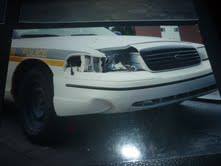
Bridget also has other questions:
Why did police not take a statement from Gladys’ neighbour, who was on the scene first?
Why did police reports not include a statement from a policewoman who was on the scene, when other officers’ statements were compiled?
Why did the Sûreté du Québec take control of the scene and not the Kitigan Zibi Police Department?
Only a second, independent investigation can answer these questions. Even if the evidence that Bridget compiled doesn’t prove Chalifoux’s guilt, it demonstrates that the original investigation was so poorly conducted that it should not have been the foundation on which a decision to press charges or proceed to trial was made. Moreover, Quebec failing to commission a second investigation would indicate that the provincial government accepts investigations riddled with contradiction, conflict of interest, and inconsistencies. Would the law enforcement officers that investigated the collision clear a suspect from another similarly inadequate investigation if their suspect wasn’t also a police officer? If they would, then why the low standard for investigations? If not, then why did they clear Serge Chalifoux?
Quebec nonetheless denied Bridget’s request for a second investigation in 2010.
Part Three: “If It Was Easy, They Wouldn’t Call It Struggle”
If you met Bridget and didn’t know what she’d gone through, you’d still get the impression that she was a juggernaut stuck trudging her way through a mire. She has an air of determination as intense as her frustration. In one photo she stands tall, unshakeable, and unfazed beside Justin Trudeau. She looks at people with eyes that are at once friendly, intelligent, and flustered. When she speaks, at vigils and on the phone, her indignation and drive grow until she shouts. But her voice becomes hoarse and her words quiver. Bridget’s determination has come at a price.
When I interviewed her, Bridget started speaking about trying to arrange a second investigation by mentioning the unexpected ways in which Gladys’ death changed her life. When Bridget was in ninth grade, she dropped out of school and started drinking to escape from the pain of her father’s suicide. “After […] they said that my mother died because she was a ‘drunken Indian,’ I quit drinking. The death of my dad got me drinking, and the death of my mom made me stop drinking. […] So if anything happens to me they can’t say I’m a drunken Indian woman.”
She also got up early in the morning and worked on her mother’s case until late at night. She sifted through reports, made phone calls, and met people non-stop for close to a year before realizing that she needed to slow down or she risked burn-out. “And I didn’t waste my time too. I went straight to the top. […] I didn’t mess around.” She has written to Members of Parliament. She didn’t just stand with Justin Trudeau; she spoke to him. She is also in touch with a lawyer from the Indigenous Knowledge Centre.
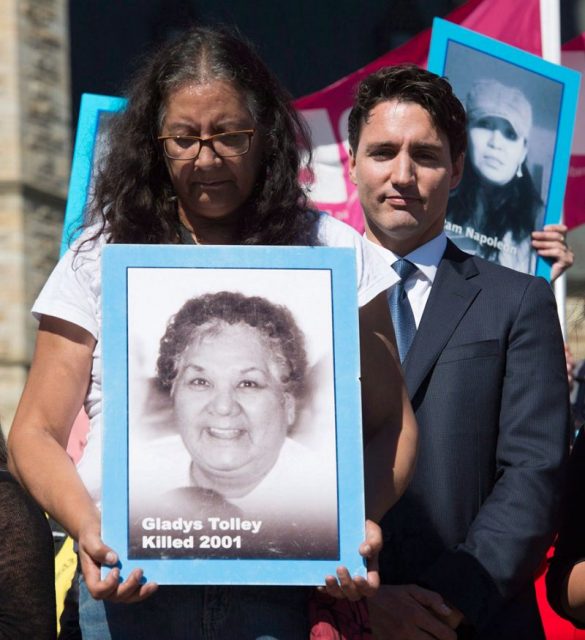
This hasn’t made her struggle easier. If anything, the number of influential people who have heard her story might only make her lack of success even more painful. Sometimes when she speaks, it sounds as if the weight of the past fifteen years is squeezing against her lungs. “Every day is a struggle. Every day to get up is a struggle. You know, I never thought justice would be political. You know, that didn’t cross my mind when I started this,” she says, her words strained between her quick, upset breaths. Even after a decade and a half, her mother’s death still causes her “raw pain.” But “nobody’s going to stop me. So many have tried to stop me already,” she said, her voice breaking as she held back tears. “And it hasn’t worked. I’m not going to stop […] What happened to my mother is real, and true, and it’s wrong.”
“The death of my dad got me drinking, and the death of my mom made me stop drinking.”
She worries constantly that her struggle won’t result in anything, and that people don’t even need to try to stop her. “It feels like I’m still in the same place that I was fifteen years ago.” When she feels hopeless, however, she remembers something that her friend Matt told her: “If it was easy, they wouldn’t call it struggle.”
Friends such as Matt are like a new family. Bridget lost a mother, but gained many sisters by joining Sisters in Spirit, a campaign led by the Native Women’s Association of Canada. They gathered information on violence against Indigenous women until the Harper government cut their funding in 2010. “This is one thing the government was trying to do – is silence us again by not funding the Sisters in Spirit,” Bridget said. “I thought that they were making us disappear again.”
Bridget refused to disappear. She co-founded Families of Sisters in Spirit, a grassroots organization that undertakes much of the same work that Sisters in Spirit did, and that draws on many of the same networks. “It makes all this worthwhile, seeing the families come together and supporting each other. […] It gives you the strength to keep going. […] I need to have that at least one percent hope to keep going.”
“I thought that they were making us disappear again.”
Bridget formed another family when she met people recovering from losses similar to her own in 2010 at the Forum Against Police Violence and Impunity. Several family members of people killed by police expressed a desire to unite. Out of death, Justice for the Victims of Police Killings was born. Finally she had met people who understood the sensation of “begging and begging and begging, and even though they hear us, they don’t hear us.”
Few things explain this feeling of being both heard and not heard better than the newly opened Bureau des enquêtes indépendantes.
Part Four: “Even Though They Hear Us, They Don’t Hear Us”
According to the “Historique” section of the Bureau’s website, the Bureau des enquêtes indépendantes arose after much public criticism of the practice that allowed police officers to investigate serious incidents implicating other police officers. The public drew attention to the potential for conflicts of interest, lack of transparency, and the absence of impartiality and objectivity.
Then, according to the website, “the government of Quebec heard the population.”
In 2012, politicians suggested modifying the “Loi sur la police” to create the Bureau, which would investigate police officers whose actions had resulted in death, “serious injury,” or were linked to illegal activities. After three and a half years of legislative wrangling and administrative organizing, the Bureau opened on June 27, 2016.
It states that its values are impartiality, rigour, and independence, and asserts in the “Mandat et Pouvoirs” section of its website that “the Bureau of Independent Investigations maintains a relationship without any link of dependence to the government of Quebec in its activities, and is not subordinate to the State or any police force in Quebec.” This statement is reassuring, until we learn that the Bureau cannot initiate investigations. Only the Minister of Public Security can prompt a Bureau investigation. The Minister initiates an investigation based on a report that the chief of the implicated police force writes after an event resulting in death or serious injury. A Montreal-based civil rights organization called Ligue des droits et libertés has expressed concerns about the chiefs being the ones who initiate the process of a potential investigation. In a document entitled “Entrée en fonction du BEI: des lacunes importantes subsistent!” they state, “Now, that implies, except when the event has resulted in someone’s death, that this chief will be the one evaluating if the nature of the injury requires a BEI investigation to take place.” The Bureau cannot even press charges. It must submit reports to the Directeur des Poursuites Criminelles et Pénales, the office of provincial prosecutors, who decide whether or not they will prosecute. Can the Bureau really be “not subordinate to the State or any police force in Quebec” when it cannot press charges, or act without authorization from the government, when the government itself is informed by reports from the implicated police forces?
This statement is reassuring, until we learn that the Bureau cannot initiate investigations.
The Bureau’s independence becomes more uncertain when one considers who it’s composed of. A selection committee consisting of Bureau director Madeleine Giauque, a representative of the Minister of Public Security, and the director of the National Police School of Quebec sifted through the applications of people wanting to work for the Bureau. Even if the committee genuinely had the independence of the Bureau as its top priority, the fact that those who handpicked the future investigators were representatives of the police training school and Ministry of Public Security, excluding Giauque, already skewed the selection. It indicated that those who’d be selected would conform to an evaluative framework that prioritised the procedures, ethos, and values of the government and the police – the organizations that the Bureau is meant to be independent from. Consequently, those chosen might not have sufficient critical distance from the organizations that they’d be investigating. There’s no evidence that the committee was some sort of cabal intentionally engineering a team of investigators who would perform great cover-ups, but without representatives from civil rights organizations or coalitions against police brutality, the selection process was skewed. As such, 14 of the 18 investigators have been police employees. Nine investigators and the three supervisors have been police officers.
Furthermore, the Bureau states that an investigator cannot take the role of principal investigator among an investigative team if said investigator was once employed at the police force under investigation. Does this imply that regular investigators can investigate the police departments where they were employed? When I called the Bureau to ask, they refused an interview.
Other organizations like Montreal Noir have criticized the Bureau for being predominantly white, and for having no Indigenous members. It claims that the Bureau “does not represent the communities most affected by police brutality; those of us who are Black, Indigenous, Latinx, trans, and otherwise marginalized.”
I asked Bridget Tolley if she would be satisfied if the Bureau des enquêtes indépendantes led a second investigation into her mother’s death?
“Absolutely not!” she replied. “It’s police investigating police – this is the big problem.” Bridget wants a civilian committee of investigators.
“It’s police investigating police – this is the big problem.”
Giauque has claimed that the Bureau needs ex-police because the investigations are very “advanced.” “I have a grade nine education and I did this alone,” Bridget said in response. “It doesn’t take a genius to figure this out.”
Part Five: The Vigil
Justice for Victims of Police Killings hosted a vigil outside of the Fraternité des policiers et policières de Montréal on October 22. The large building of beige brick and glass walls covered in “Libre Négo” stickers was surrounded by a few dozen people. A row of police officers stood at the top of the building’s granite steps, at the bottom of which were Bridget and Julie Matson, another co-founder of Justice for Victims of Police Killing. The sound of their quiet conversation mixed in with the French hip-hop playing from speakers covered in a blue, crinkly tarp. In front of the speakers were framed photographs of victims of police killings. Through the raindrop-covered glass of the frame, Gladys Tolley beamed at the sombre crowd.
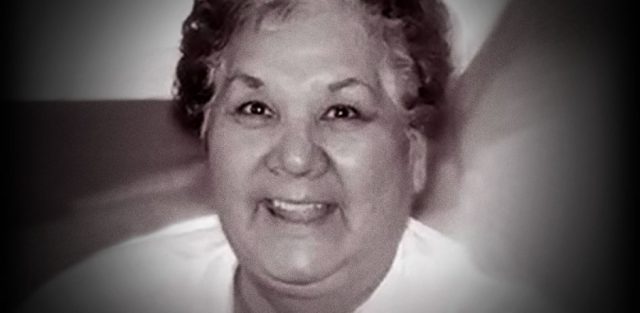
Bridget was holding a large poster of that photo, and a braid of sweetgrass. Her eyes glimmered, but, unlike Gladys, she was sombre as she and the other organizers moved in front of the granite steps. Jaggi Singh, a local organizer, introduced the speakers to the crowd. Soon he passed the microphone to Bridget. Singh manoeuvred around her, stepping onto the second of the five granite steps so that he was behind her, and tilted a black umbrella over Bridget. Her face was glum.
“Hello. Bonjour. Thank you for coming out today on this rainy day,” she began.
Staring out at the crowd, Bridget paused and Julie Matson put a white mitted hand around Bridget’s shoulder as one of the police officers tapped Singh’s shoulder. When Singh didn’t respond, the officer tapped his shoulder again. Then the officer stepped down and leaned toward Singh, perhaps whispering something.
“We’re here today to honour our loved ones who were killed by police,” Bridget continued.
The officer nudged Singh who stood still, staring ahead with tense resolution in his eyes and tight-set lips. The officer flashed an exasperated smile to a partner on his left, then pushed Singh, and this time his body rocked forward, and his fingers tightened around the steel railing beside him. A third officer stepped toward Singh.
“I think this rain is appropriate for today,” Bridget said. The officer smirked with amusement and annoyance before returning to the top step. Singh held the umbrella with that same determined half-frown. Bridget fixed the crowd with her weary but stony eyes. “‘Cause I feel it’s tears from up above, happy tears because we’re here, and sad tears because our cases are not being done right.”
This story used the following sources: “Rapport Annuel,” by the Bureau des enquêtes indépendantes; “Tenue d’une enquête indépendante” in the “Loi sur la police”; “Règlement sur le déroulement des enquêtes du Bureau des enquêtes indépendantes,” in Gazette officielle du Québec; “Règlement sur la procédure de sélection et sur la formation des enquêteurs du Bureau des enquêtes indépendantes,” in the “Loi sur la police”; “Tripartite Police Agreement” between Kitigan Zibi Anishinabeg band council, Quebec, and Canada; the website of the Bureau des enquêtes indépendantes; Ligue des droits et libertés, “Entrée en fonction du BEI : des lacunes importantes subsistent!”; Interviews with Bridget Tolley; “Histoires troublantes sur la surveillance des enquêtes policières” in La Presse; “Le Bureau des enquêtes indépendantes clame sa transparence,” in Journal de Montréal; “La directrice du Bureau des enquêtes indépendantes se veut rassurante, in Radio-Canada; “Police Killings in Canada: Anatomy of a Crisis,” in Ricochet; “Bridget Tolley’s search for justice for her mother,” in Rabble; “Police Impunity,” in the McGill Daily; “Journey for Justice: Story of Gladys Tolley” by Native Women’s Association; “Interview with Bridget Tolley” by Black Coffee Poet; “Montréal Noir et les familles de personnes tuées par la police rejettent le Bureau des enquêtes indépendantes,” on the website of Collectif Opposé à la Brutalité Policière.

